 |
 |
|
 |
Pawlenty, Molnau propose $2.5 billion transportation investment plan |
 |
 |
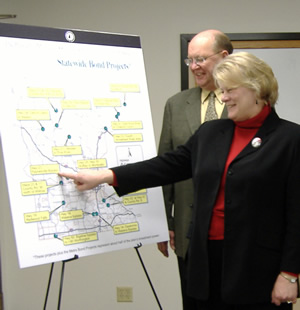 |
|
Lt. Gov./Commissioner Carol Molnau and Bob Winter, District Operations Division director, point out three projects in District 8 that would be accelerated under the administration's proposed $2.5 billion transportation investment plan. Willmar was one of eight locations the governor and lieutenant governor traveled to Feb. 1 to make their announcement. Photo by Diane Beck |
Gov. Tim Pawlenty and Lt. Gov./ Commissioner Carol Molnau today proposed a $2.5 billion transportation investment plan that would accelerate dozens of major highway projects across the state through use of highway bonds.
The governor and lieutenant governor traveled Feb. 1 to eight locations statewide to announce their plan.
The proposal is linked to passage of a state constitutional amendment that will be on the general election ballot in November. If passed, the amendment would permanently dedicate 100 percent of the revenue generated from the Motor Vehicle Sales Tax to highway and transit projects. Currently, only 54 percent of MVST revenues are distributed to highways and transit. The new MVST revenues would be used to finance the highway bonds.
The lieutenant governor highlighted 22 major highway projects throughout the state that would be accelerated if the Legislature passes the administration’s proposal and voters pass the constitutional amendment. These projects represent about half of the plan’s investment power, leaving room for other projects to be added, Molnau said.
The highlighted projects, which have been delayed or unfunded for years, were drawn from statewide long-term programming plans and would address congestion, provide capacity improvements, remove bottlenecks and improve statewide interregional corridors.
Related information:
|
back

|
 |
Fierce winds churn snow showers into dangerous winter storm |
 |
 |
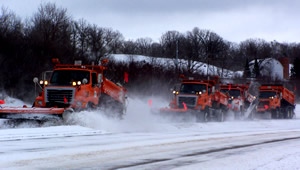 |
|
Snowplow operators went out in a tight, four-plow formation to clear snow on Hwy 59 near Detroit Lakes during the Jan. 23 storm. High winds and blowing snow often hampered their operations. The plows were driven by Mike Dretch, Vern Jorgenson, Mark Kolher and Lyle Rudolph. Photo by Bill Hanson |
Snow squalls turbocharged by winds exceeding 50 miles an hour raked western Minnesota on Jan. 23, slicing drivers’ ability to see ahead to only a few hundred feet.
The fierce winds also stirred already fallen snow into the mix, forcing many drivers off the roads until visibility improved.
Tom Zimmerman, maintenance superintendent at Windom/District 7, said rain in the area soaked existing snow and kept it from blowing, but wind gusts greater than 60 miles an hour created problems of their own.
In places, the wind blew snow across highways at ground level, causing icy spots, he said. High winds also caused a semi-trailer truck to overturn on Interstate-90 near Jackson and a similar incident on Hwy 14 near Springfield.
Detroit Lakes/District 4 officials closed I-94 between Fergus Falls and Moorhead for several hours when the wind-whipped snow caused nearly white-out conditions.
“High winds and snowstorms don’t mix,” said Dean Olson, district maintenance supervisor at Morris.
Olson said many cars and trucks slipped into ditches along I-94, Hwy 10, Hwy 59 and other routes.
He said there were no serious injuries reported in the area as a result of the storm. Mn/DOT snowplow crews kept working during the storm, picking their way carefully along their plow routes until the skies eventually cleared.
“It could have been worse; we had temperatures of 20 degrees above 0, not 20 below. And when the sun came out, the roads dried out pretty quickly,” Olson said. “Minnesota could have sent us weather much more severe than this.”
Zimmerman said the Windom Maintenance Area has used more salt than usual because of rain, freezing rain and other icing conditions.
He said, though, there is a silver lining in the nearly month-long siege of unseasonably mild temperatures and clouds blanketing most of Minnesota.
“It’s warm, so now we can start to catch up with our pothole patching,” Zimmerman said.
By Craig Wilkins
|
back

|
 |
Grand ceremony celebrated completion of I-90 in Minnesota, nation |
 |
 |
In a celebration that echoed opening the first transcontinental railroad more than 100 years earlier, people flocked to Blue Earth on Sept. 23, 1978 to mark completion of the final section of Interstate 90, the nation’s longest interstate route.
The event marked completion of the last section of the interstate in Minnesota which was the final link in I-90 that connects Boston with Seattle, a distance of more than 3,000 miles.
The last section extended about 14 miles between Frost and Guckeen.
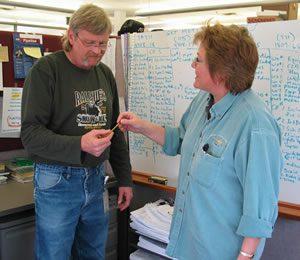 |
Paul Koenig, a construction project supervisor at Baxter, shows a memento of completing I-90, a pen resembling a railroad spike, to Robin Elstad, Construction Office manager at Baxter. Photo by Jenny Seelen |
Like the golden spike driven to commemorate the transcontinental railroad, the event included placement of gold-tinted concrete pavement panels and distribution of commemorative pens that resembled the legendary golden spike.
The dedication also included speeches by federal, state, regional and local leaders. Speakers included former U.S. Secretary of Transportation Brock Adams, former governor Rudy Perpich, and former governor and U.S. Sen. Wendell Anderson.
Mn/DOT employees who worked on building I-90 said there was intense pressure to complete the job because of its national significance. Delays such as having to excavate vast areas filled with muck also added pressure on the project, said Paul Koenig, now a project supervisor with District 3 at Baxter.
Koenig worked as a grading inspector on I-90 for about three years, often putting in 12- to 14-hour days. Working on weekends was not unusual.
Koenig said he worked the morning of Sept. 9, his wedding day, to keep the project on track.
“I had strict orders from my bride-to-be not to be late for our 4 p.m. ceremony,” he said.
He wasn’t.
Koenig and his spouse, Lori Koenig, will celebrate their 28th anniversary this year.
Related information:
By Craig Wilkins
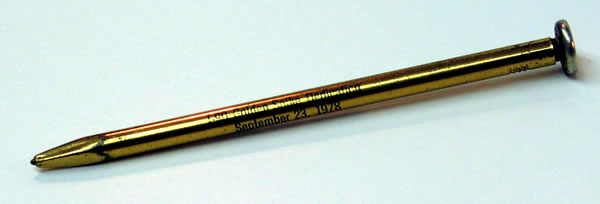 |
Pens resembling a golden railroad spike were distributed Sept. 23, 1978 to commemorate the completion of I-90 in Blue Earth. Photo by Jenny Seelen |
|
back

|
 |
Alert District 4 maintenance workers find pipe bomb along Hwy 10 |
 |
 |
A pipe bomb found by a District 4 maintenance crew on the Hwy 10 median near Hawley illustrates the need for Mn/DOT employees to remain alert to their work environments.
Dan Leister and Wes Green of the Hawley truck station found the bomb Jan. 26 in a highway crossover.
They discovered the plastic pipe filled with gunpowder while clearing snow about two miles west of Hawley.
Dennis Redig, area maintenance superintendent, said Green saw the white object lying in the crossover just before he and Leister started to remove snow from the median area.
Leister called State Patrol Officer Howard Hanson, who had driven by just moments before. Hanson confirmed that the pipe, which was capped on both ends, could contain a bomb and called a regional bomb disposal unit to remove it.
The State Patrol closed a section of Hwy 10 briefly while the bomb was removed from the median, taken to a remote location and detonated.
News reports stated that Clay County Sheriff Bill Bergquist said he didn’t believe the bomb was placed deliberately in the median.
District Engineer Lee Berget praised the two employees for their quick reaction to a potentially dangerous situation.
“We remind employees to be alert to their surroundings,” he said. “We’re happy to see people react to suspicious objects or situations as they have been trained.”
Related information:
By Craig Wilkins
|
back

|
 |
Mn/DOT, Office of Enterprise Technology will explore new model to deliver information technology services |
 |
 |
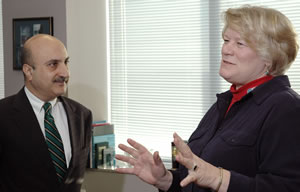 |
|
Lt. Gov./Commissioner Carol Molnau and Gopal Khanna, director of the state’s Office of Enterprise Technology, talk at the signing of the IT partnership agreement. Photo by David Gonzalez |
Mn/DOT and the state’s Office of Enterprise Technology formally agreed to jointly develop a new model for delivering information technology services.
The agreement was signed Jan. 30 by Lt. Gov./Commissioner Carol Molnau and OET’s Gopal Khanna, the state’s chief information officer.
Mn/DOT is the first agency to partner with OET.
Under the agreement, the agencies will explore ways to find efficiencies and improve IT service delivery.
They will use the “federated” management model to determine which IT functions are agency-specific, those that Mn/DOT can share with one or more agencies and those that can be used by all state agencies.
Mike Barnes, director of agency collaboration with OET, said examples of an agency-specific IT function includes those such as GeoPak or Mn/DOT's construction management system. (Barnes is on a temporary assignment with OET; Mjykhael Nelson serves as Office of Information Technology director during his absence.)
He said an example of a shared resource is the M-5 program that agencies, including Mn/DOT and the departments of Administration and Natural Resources, use to manage their vehicle fleets.
IT services such as e-mail used by nearly every agency are classified as “utility” in the federated model.
Mark Wikelius, Mn/DOT’s Drive to Excellence director, said the partnership will use Mn/DOT’s expertise to develop a delivery model that will ensure the most efficiency and best customer service and one that can be used by other agencies as well.
“Our goal is to manage IT resources wisely so that Mn/DOT and other agencies can better focus on their core missions and service to the public,” he said.
Wikelius said the agreement mirrors Drive to Excellence achievements such as the recently consolidated program that enables citizens to obtain hundreds of different licenses from several agencies by using one Web site.
Molnau said she expects the agreement will affirm the Drive to Excellence program’s emphasis on collaboration and creative problem-solving.
“For Mn/DOT, it’s an opportunity to maintain quality IT services while allowing to focus on our primary mission, serve our customers better and better manage our resources,” she said.
Related information:
By Craig Wilkins
|
back

|
 |
Public television stations to air segment on Tribes and Transportation Conference |
 |
 |
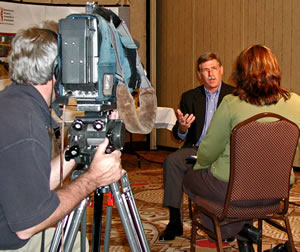 |
|
During a break at the Tribes and Transportation Conference last October, Mike Robinson, Duluth/District 1 engineer, talks to Juli Kellner, WDSE-TV, for a segment on the public television series “Native Report.” The segment will be televised in the Duluth area Feb. 2. Also shown is photojournalist Ted Pellman. Photo by John Bray |
The annual Minnesota Tribes and Transportation Conference will be featured on this week’s edition of “Native Report,” a Duluth-based public television series that covers tribal issues and stories.
Locally produced by WDSE-TV, the program will air in the Duluth area on Feb. 2 at 8:30 p.m. and in the Bemidji area on Lakeland Public TV during the first week in March (check local listings for time and date). A broadcast schedule of the program on other public television stations in Minnesota and nationwide is pending.
The 15-part series covers Native American culture, heritage, arts, issues and current events in Minnesota, as well as highlights stories from each of Minnesota’s 11 reservations. The Tribes and Transportation Conference was selected as a topic for one segment because the event annually brings together tribal leaders with state, local and federal government leaders to discuss transportation infrastructure planning and improvements.
Among those interviewed for the Feb. 2 program were Lt. Gov./Commissioner Carol Molnau, Linda Aitken, Mn/DOT’s tribal liaison, and Mike Robinson, Duluth/District 1 engineer. The three were interviewed during the Tribes and Transportation Conference, held last October in Mahnomen.
During his interview, Robinson highlighted District 1's long-running relationship with the tribes in northeastern Minnesota. He also described the many projects that Mn/DOT has worked on with different tribes in the district, the most recent being the replacement of the Little Fork River Bridge in partnership with the Bois Forte Band of Chippewa.
“It’s important we learn about the cultural values of the various tribes,” Robinson said. “Tribes are sovereign nations, where government-to-government respect and protocols must be observed in order to build strong, productive relationships.”
Copies of the program will be available in May.
Related information:
|
back

|
 |
New 511 system improvement provides more precise road condition reports |
 |
 |
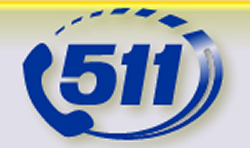 |
|
The Condition Acquisition Reporting System eVoice now allows maintenance workers to report current road conditions on specific stretches of roadway by telephone. Previously, the CARS reports were only on countywide conditions. |
A new tweak to Mn/DOT’s 511 traveler information system will give drivers more accurate reports on driving conditions on specific roadways.
The change is the addition of the Condition Acquisition Reporting System eVoice. It is a telephone-based reporting option that allows maintenance workers on the roadways to call and report current road conditions on specific sections of highway. Prior to this innovation, the CARS reports were only on countywide conditions.
“This will definitely improve 511,” said Deb Fick, the 511 program manager. “It will show the driving conditions on major road segments as well as what the conditions are countywide. Often, motorists discover that the conditions across the county might be poor, but the conditions on the major freeways are good because those roadways are plowed and treated first.”
Most of the reporting on conditions comes from snow plow operators. The conditions are based on the routes the operators cover during snow and ice events. Operators call into the system via cell phone or landline, and enter the road conditions for the roadway either by speaking or using the telephone keypad to punch in the conditions.
For instance, the operator will be prompted to enter driving conditions by the system (“Say one for good, two for fair . . .”). The operator then will be prompted to enter pavement conditions, such as “treated,” “plowed snow,” “wet” or “icy.” They are prompted to enter additional pavement conditions, such as “icy patches,” “black ice” or “melting snow.”
All of the descriptions used in the system are standard terms familiar to the maintenance operators, ensuring that the terms are consistent across the state. The reported data gets fed into the CARS database system and posted to the 511 Web site.
Fick said the system was tested in District 7/Mankato for a year before it was implemented statewide.
“At first, there was some apprehension about assigning maintenance staff yet another duty. However, the operators really took to the system and are now very serious about issuing timely reports,” she said.
Related information:
By Kevin Gutknecht
|
back

|
 |
Twin Cities region completes 250th mile of bus-only highway shoulders |
 |
 |
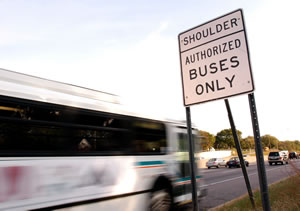 |
|
A transit bus uses the bus-only shoulder on southbound I-35W during a peak in traffic levels. Photo by David Gonzalez |
The Twin Cities metropolitan area marked a milestone with completion of the region’s 250th mile of highway shoulder improved for use by transit and other buses.
The region has the most miles of bus-only shoulders in the United States.
The region’s first bus-only shoulders were built along a section of Hwy 252 in Brooklyn Center in 1992, said the Metro District’s Jennifer Conover, Team Transit chair. (Team Transit includes Mn/DOT, Metro Transit, other transit providers as well as city and county governments in the region.)
The newest bus-only shoulders include 4.7 miles on Hwy 62 between Penn Avenue and Hwy 212 between Minneapolis and Eden Prairie and a two-mile section on eastbound Interstate 494 between Hwy 5 and Hwy 169 in Bloomington. One-mile sections were also added to I-94 in Maplewood.
The projects were completed in December.
Strengthening the shoulders, Conover said, entails adding seven inches of asphalt pavement on the 10- to 12-foot-wide shoulders. In addition, concrete pads are built around drainage catch basins to reduce the impact from the buses.
Legislation passed in 2002 gives Mn/DOT formal authority to permit bus operations on highway shoulders and specifies their use.
 |
Jennifer Conover, Metro District, Team Transit chair. Photo by David Gonzalez |
Buses are allowed to use the shoulders only when traffic is severely congested. When using the shoulders, buses cannot travel more than 15 miles per hour faster than regular traffic. Buses are also required to leave the shoulders and rejoin traffic when speed of traffic flow reaches 35 miles an hour.
Since 2002, bus shoulders have been constructed on I 94, I-35 and other major Twin Cities area highways.
Conover said Metro Transit and the Center for Transportation Studies are collecting data from buses via their GPS systems to determine future need for the bus-shoulders or other changes.
“Data obtained via the GPS and automated passenger counters show bus and traffic speeds, precise numbers of passengers who enter or leave the bus at each stop and disruptions in the traffic flow that may require rerouting the bus, adjusting schedules or additional bus-shoulders,” she said.
The next section of freeway scheduled to have bus-only shoulders, she said, is a short section of westbound I-94 at its interchange with Hwy 280 in St. Paul.
“Building the bus shoulder in this area will be more complicated than on other routes, but the ability to move more people will benefit both transit riders and motorists,” she said.
By Craig Wilkins
|
back

|
 |
Transit will conduct ‘listening post’ meeting for ideas on coordinating transit services |
 |
 |
Staff from the Office of Transit will don their listening hats during a series of meetings to gather ideas and suggestions about ways to better coordinate transit services statewide.
The first meeting will be held Feb. 6 in Willmar.
The listening sessions are part of formulating a plan to improve service, efficiency and flexibility for the state’s transit providers by improving coordination among them, said Noel Shughart, a project manager with the Office of Transit.
Shughart said Mn/DOT and the Metropolitan Council are conducting the study.
The plan, he said, seeks to involve transit providers including city, county and regional public transit agencies and other providers such as hospitals, social service agencies and nursing homes to coordinate services they provide.
“By linking public and community services, we hope to improve service quality, increase the availability of transit services and enhance access to work and school for residents throughout the state,” he said.
Subsequent meetings will be held in St. Cloud, Detroit Lakes, Bemidji, Duluth, West St. Paul, Windom and Rochester.
|
back

|
 |
Arnebeck serves as acting director of Operations, Safety and Technology |
 |
 |
Rick Arnebeck will serve as acting division director of Operations, Safety and Technology until a successor to Marthand Nookala is named.
Nookala was appointed as Hennepin County’s public works director last month.
Arnebeck, Office of Maintenance director, will stay in his current office. His phone number remains 651/297-3590.
|
back

|
 |
|
 |



